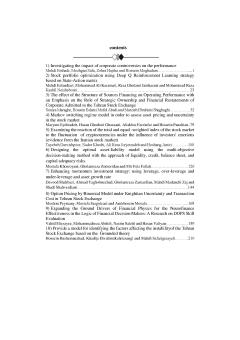Designing the optimal asset-liability model using the multi-objective decision-making method with the approach of liquidity, credit, balance sheet, and capital adequacy risks.
Subject Areas : Financial engineering
mostafa khosroyani
1
![]() ,
Gholamreza zomorodian
2
*
,
mirfiz fallahshams
3
,
Gholamreza zomorodian
2
*
,
mirfiz fallahshams
3
![]()
1 - financial management department ,central branch ,Islamic azad university ,Tehran , Iran
2 - Department of Financial Management, central Tehran Branch, Islamic Azad University. Tehran, Iran and member of Modern Financial Risk Research Group
3 - Department of Financial Management, central Tehran Branch, Islamic Azad University. Tehran, Iran and Faculty member of islamic azad univesity
Keywords: goal programming, Risk, asset and liability management,
Abstract :
In this research, asset and liability management, which is one of the most important things done by banks, is examined. The methods and complexity of the process used to manage assets and liabilities depend on the size and complexity of the portfolio. Bank Mellat, as one of the most central banks in the country, in line with its organizational goals and missions, needs accurate economic planning and high-yield investments in order to maintain the value of depositors' reserves and provide the necessary resources to fulfill its long-term and short-term obligations. According to the stated content, the main problem of this research consists in the fact that due to the importance of asset and liability management with the approach of liquidity risks, credit, balance sheet, capital structure as a comprehensive approach that includes different types of important risks and It includes the important, it should be noted. In this research, we consider asset and debt management with more important factors in this matter, so that the model is more efficient than the previous models presented, which has been taken into account with the approach of goal programming.
_|1) بانک اقتصاد نوین، پروژه توسعه¬ نرمافزار مدیریت ریسک گروه مطالعات و مدیریت ریسک بانک اقتصاد نوین (1387)، مدیریت دارایی بدهی و ریسک نقدینگی در مؤسسات مالی، چاپ دوم، نشر تهران، انتشارات فرا سخن. ص 12
2) فلاح شمس، میر فیض، حسنزاده، نقشینه، کردلویی، پور زرندی (1392)، مدیریت داراییها و بدهیهای بانکی، چاپ 2، نشر تهران، انتشارات گپ، ص 43
3) پورزرندی، محمدابراهیم، منصور (۱۳۸۵)، طراحی و تدوین الگوی ارزیابی آثار اعمال مدیریت دارایی و بدهی در بانکها با استفاده از مدل برنامه¬ریزی آرمانی، ریاضیات کاربردی واحد لاهیجان، شماره ۱۱، زمستان ۸۵. ص 77
4) Arzu Tektas, E. and gunay, G. (2005) Asset and liability Management Financial Crisis. The journal Of Risk Management vol No. 2. 2, p 5
5) Giokas, D. and Vassiloglou, M. (1991), “A goal programming model for bank assets and liabilities management”, European Journal of Operational Research, Vol. 50 No. 1, pp. 48
6) Chen, J. W., Lam, W. S., Lam, W. H. (2011). Optimization on the financial management of the bank with goal programming model, Journal of Fundamental and Applied Science, vol No. 2. 2, p 12
7) Booth, G.G. and Bessler, W. (1988), “Goal programming models for managing interest-rate risk”, Omega, Vol. 17 No. 1, pp. 81.
8) Booth, G.G. and Dash, G.H. (1979), “Alternate programming structures for bank portfolios”, Journal of Banking and Finance, Vol. 3, 4, pp. 67
9) Cohen, K.J. and Hammer, F.S. (1967), “Linear programming models for optimal bank asset management decision”, Journal of Finance, Vol. 22 No. 2, pp. 42.
10) Eatman, J.L. and Sealey, C.W. (1979), “A multiobjective linear programming model for commercial bank balance-sheet management”, Journal of Bank Research, Vol. 9, Winter, pp. 227
11) Forston, J.C. and Dince, R. (1977), “An application of goal programming to management of a country bank”, Journal of Bank Research, Vol. 7, pp. 311.
12) Gu¨ven, S. and Persentili, E. (1997), “A linear programming model for bank balance-sheet management”, Omega, Vol. 25 No. 4, pp. 449.
13) Zopounidis, C. (1999), “Multicriteria decision aid in financial management”, European Journal of Operational Research, Vol. 119 No. 2, pp. 404
14) 14. Biety, Monie. (2012). An introduction to liquidity and asset management, World Council of Credit Union, vol 6, 2, p.p 20
|_

